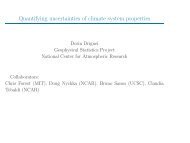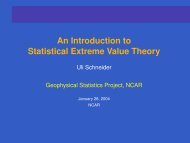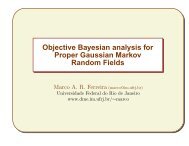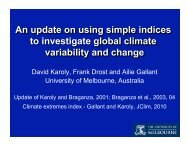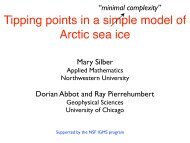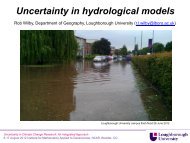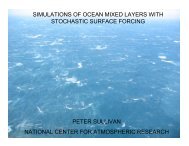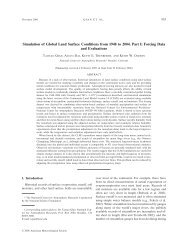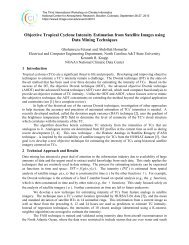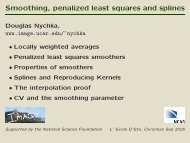A Spatial Analysis of Multivariate Output from Regional ... - IMAGe
A Spatial Analysis of Multivariate Output from Regional ... - IMAGe
A Spatial Analysis of Multivariate Output from Regional ... - IMAGe
You also want an ePaper? Increase the reach of your titles
YUMPU automatically turns print PDFs into web optimized ePapers that Google loves.
Figure 5: Posterior means for the regression (left), the spatial effect (middle), and the sum(right) for the winter season. The top row represents the change in midpoint temperature( o K), while the bottom represents the change in total precipitation (inches).two conditional cross-correlation parameters is clearly shown in the left frame <strong>of</strong> Figure 4.However, there is another feature <strong>of</strong> note: There is compelling evidence <strong>of</strong> asymmetry in thestrength <strong>of</strong> these two parameters, with roughly 85% <strong>of</strong> the sampled points being above theline y = x. This suggests that there is higher conditional dependence between temperaturevalues and neighboring total precipitation than there is conditional dependence betweentotal precipitation values and neighboring temperature values. Almost all <strong>of</strong> the publishedmodels <strong>of</strong> multivariate MRFs assume φ 12 = φ 21 , something we have argued previouslyas being overly restrictive (Sain and Cressie, 2007). Our posterior inference shows theinappropriateness <strong>of</strong> such an assumption in this case.Figure 5 shows posterior means for the fixed regression components (left column), thespatial random effects (middle column), and their sum (right column), for the change inwinter average temperature (top row) and the change in total winter precipitation (bottomrow). The fixed effects show a clear latitudinal effect as well as an east-to-west gradient. For19



